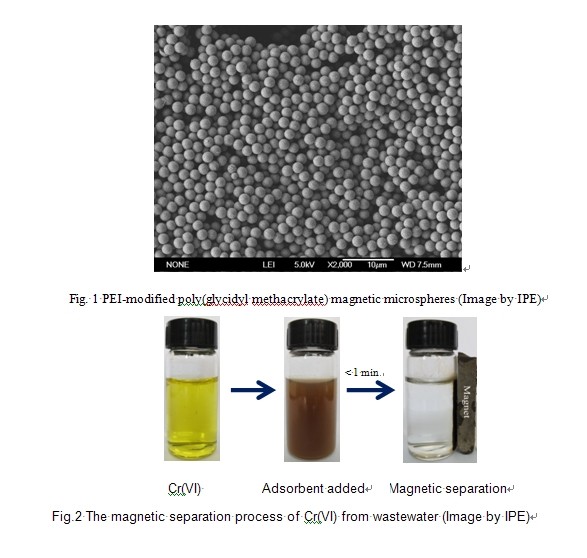Chromium(Cr)(VI) existed wildly in the wastewater of many industrial processes such as electroplating, chromic salts industry, pigment manufacture and leather tanning. It is well known that Cr(VI) is carcinogenic and mutagenic to living organisms. Therefore, it is urgent to remove Cr(VI) from wastewater before their discharge into the environment. Among the conventional treatment methods, adsorption has evoked considerable interest owing to its superior features, such as low technological equipment and operation cost, simple recovery of metal ions and reusability of the adsorbents.
Currently, a variety of adsorbents have been developed for Cr(VI) removal. However, the majority of adsorbents in the past studies have the disadvantages of low adsorption capacity, slow adsorption rate and complicated recovery from aqueous solution. Therefore, exploring a magnetic adsorbent with large adsorption capacity and rapid adsorption rate is a goal of general concern.
The research team led by Prof. Liu Huizhou at Institute of Process Engineering (IPE), Chinese Academy of Sciences, has developed novelamino-functionalized poly(glycidyl methacrylate) magnetic microspheres (m-PGMA-PEI) with polyethylenimines modifying reagent (Fig. 1). The microspheres exhibited a large amino group capacity (6.25 mmol/g) and a high saturation magnetization (8.6 emu/g). With such saturation magnetization, they could be easily and quickly separated from a suspension by applying an external magnetic field (Fig. 2).
The application of m-PGMA-PEI microspheres for Cr(VI) removal from wastewater was studied by batch adsorption method. The results demonstrated that the microspheres showed a high adsorption capacity with the maximum adsorption capacity of 492.61 mg/g, which is much higher than others reported. The Cr(VI) adsorption rate is rapid, and the adsorption reach equilibrium within 15 min. The regeneration study revealed that the adsorbent has a good reusability.
In conclusion, the m-PGMA-PEI should be a promising adsorbent for Cr(VI) removal. These achievements laid a foundationfor high efficient magnetic separation of Cr(VI) from wastewater and published in Chemical Engineering Journal (2013, 234: 338-345).(By IPE)

 Search
Search




 京公网安备110402500047号
京公网安备110402500047号